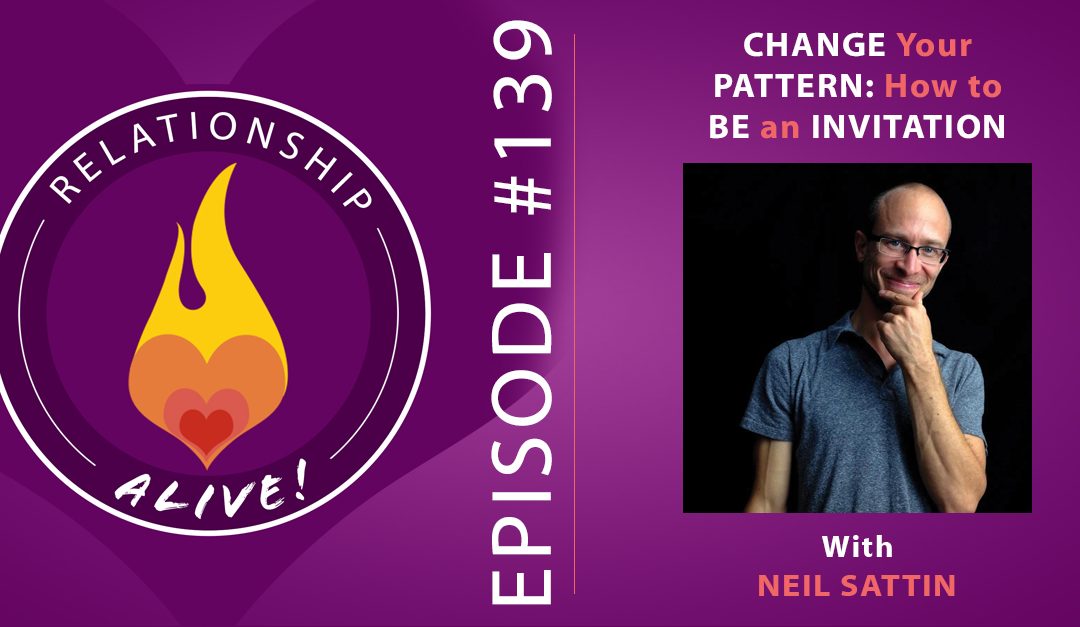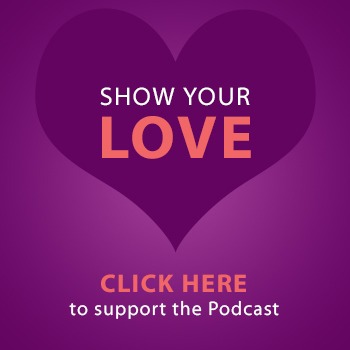How do you invite someone into your world, your truth, your desires? When you have a complaint, how do you invite someone to the table about it in a way where they WANT to respond and help make things right? And, most importantly, how do you invite someone to be who they truly are? Today's show is all about how to "be an invitation", and whether you’re in a relationship, or single and looking to connect, the art of being an invitation can completely transform how you connect with another person. By the end of today's episode, you will have clear strategies to figure out how to improve your connection with the people in your life who matter most.
Resources:
Join the Relationship Alive Community on Facebook
FREE Guide to Neil's Top 3 Relationship Communication Secrets (or text "RELATE" to 33444)
Guide to Understanding Your Needs (and Your Partner's Needs) in Relationship (ALSO FREE)
Support the podcast (or text "SUPPORT" to 33444)
Amazing intro and outro music provided courtesy of The Railsplitters
Transcript (more or less):
Now, what does it mean to be “an invitation”? And why is it so important to the long-term success of your relationship?
At its core, being an invitation is all about play. How do you encourage play in your relationship? Play is the energy that keeps things fun, and light - and can help you through a darker time in your relationship. I’m not necessarily talking about silliness - although that’s a great quality to be able to foster in your connection. “Play” is the energy of creative collaboration, and it requires you and your partner to both be as present as possible. And not only present, but also relaxed, engaged, attentive, responsive.
So being an invitation is the way that you interact with another person, inviting them to “come to the party” with you - so to speak. So at its simplest level, you might ask yourself - is the way that I’m interacting with other people encouraging them to be who they are? I’m going to give you a few questions to help you figure this out. And then, after that, I’m going to give you one key that ties it all together. Without this key, you can invite all you want without actually connecting with a person. So I’ll reveal that in a moment.
But first, how do you figure out if you’re inviting someone to the party with you. You can ask yourself questions like...
Am I being curious about them, and their experience?
Am I showing them that they are safe with me, that I’m not judging them?
Am I willing to notice what’s actually going on with a person - and to validate what I’m noticing through my curiosity? In other words - what do you think is going on with a person? How and why do you think that? And then, once you notice you’re thinking it, do you check in with them to find out whether or not it’s true?
Now why are all of those things so crucial? They are all about giving someone evidence that you are there, with them. And, on top of that, through being curious, you are giving your partner an opportunity to tune into themselves more deeply, to be in touch with their own experience. So as much as you’re inviting them into the dance with you, you are also inviting them into their own inner dance. What IS going on within them? And how is it a reflection of how they want to be in the world? Or are they being how they DON’T want to be?
You can say things like this - “I’m noticing that you’re doing this thing with your face, and it makes me wonder if I just said something that you didn’t like?”
Or - “I’m noticing that you’re taking shallow breaths...are you nervous right now? Or is something else going on?”
Now these are just a couple of examples - and there’s a fine line between asking these kinds of questions in a way that feels like an invitation, and asking them in a way that feels like an interrogation.
So now I’d like to give you the important key that brings it all together.
Can you show up this way, while at the same time revealing something of who YOU are? Bringing your own courageous vulnerability online in these moments?
The first part of being an invitation is inviting someone to the dance with you. The second part is your willingness to invite them into your world, into your experience. When someone learns what’s going on with you, and at the same time staying related to them - it’s an important component of them feeling safe with you.
I’m not talking about the kind of conversation where someone tells you something and then you turn it into being about you. We’ve all been in those kinds of conversations and those, rather than making you feel safer and more connected, can leave you feeling frustrated and like you’re not being considered.
So, by being open about how your experience of and with another person is affecting you, and at the same time, staying connected to their experience - that is perhaps one of the most powerful invitations that you can offer.
So it might be something like this:
“I’m noticing that you have this expression on your face, to me it almost looks like you’re in pain. And what I’m noticing within myself is that I’M getting really nervous, like I might have said something to offend you. Is that what just happened?”
Generally the safest thing is to start with the physical - what are you actually noticing about another person? And then what are you making it mean? And then...what is your OWN experience, your own feeling? And then...check in with the other person. Do they validate your feeling? Do they reveal something about themselves that you never could have guessed?
However, you could also just start with a feeling that you’re getting. Maybe you’ll be right on - or, maybe you’ll be way off. Can you present your feeling as a question, instead of as a fact? And can you reveal your own heart, so that the other person knows the impact that they are having on you?
Something like “wow, when you told me that I noticed that I got this sinking feeling in my gut. Does that relate to how you’re feeling about it?” - or - “Wow, I’m just feeling so elated after hearing that. I’m so excited for you. What was it like for you to have that experience?”
Then you get to see what happens next. And this is another reason why being an invitation is so important - especially if you’re single. You get to learn something about how the other person either does, or doesn’t, show up in this context. Do they want to play with you? Do they respond to your open heart with their own open-heartedness? Do they get flustered? Do they reflect before interacting, or do they just stay on autopilot? Do you get the sense that they are more THERE, more present with you? Does your interaction take on more of a quality of aliveness? Or does the other person get all triggered, and check out? And if that’s what’s happening - how do you know? What are the signs that you’re seeing?
Now...what about if you’re already in a relationship with this person?
Yeah, if you’re in a relationship, what do you do if your partner doesn’t immediately start to dance with you? Well, it could be that you’re really stuck in a rut, and so this can take some work to undo the patterns of the past. This is a great opportunity for you to get support, from a coach or a therapist, to get unstuck in your relationship, to have some guidance around re-patterning.
And, know that if you’ve been doing it one way for awhile, it can take a little time to make the switch to a new way of being, for your partner to actually get that you’re doing something different now. After all, if you haven’t been an invitation all this time, then it might take some time for your partner to actually trust that it’s safe to fully be there, with you, at the dinner table. And that’s ok, a natural part of the process. You’re both discovering here - discovering yourselves and perhaps re-discovering each other. If you start to see how you HAVEN’T been inviting your partner, all along, then you might start by taking responsibility for your part, for all the ways that you have either overtly or covertly been encouraging your partner to NOT be who they are, to not be unguarded with you. Ways that you have perhaps punished their vulnerability.
At this point in our world, there aren’t many people who have truly mastered this relationship skill. It takes practice, not only to do it, but also to UNdo all the ways that you were actively promoting the opposite kind of dynamics in your connection with your partner, or with the people around you. So don’t be hard on yourself if it’s a little awkward, or if it misfires a few times. It takes time. This is another place where getting coaching or support can be helpful, because you get to practice in an environment that’s safe for you - as well as getting to learn by example.
More than anything, I encourage you to….play. Experiment. Try it out with the people who matter in your life, sure - but you can also try this out if you’re standing in line at the grocery store, or when you’re at the gym, or buying a paleo bagel at the local coffee shop. And yes, there are paleo bagels. Well, grain-free bagels anyway. The point is - this is something that you can play with wherever you are, and wherever there are other people. It’s easiest to do when you’re actually interacting with people.
And whether you want support, or you want to simply let me know how your experiments are going - feel free to reach out to me via email: neilius @ neilsattin .com - I get lots of email so I can’t promise that I’ll be able to respond, but I will definitely read your email - and it’s always great to know what’s happening with you.
That’s it for me, for this week. We’re still deep in the move here, sorting through boxes and boxes. I’m looking forward to seeing you next week, where you will be able to hear me get REALLY vulnerable in a conversation with Dick Schwartz, the creator of Internal Family Systems. This is our second conversation for the relationship alive podcast, and we’re going to dive even more deeply into how your inner world, and inner work, can help you show up more courageously, clearly, and compassionately in your own life. See you next week, and, until then, take care!


